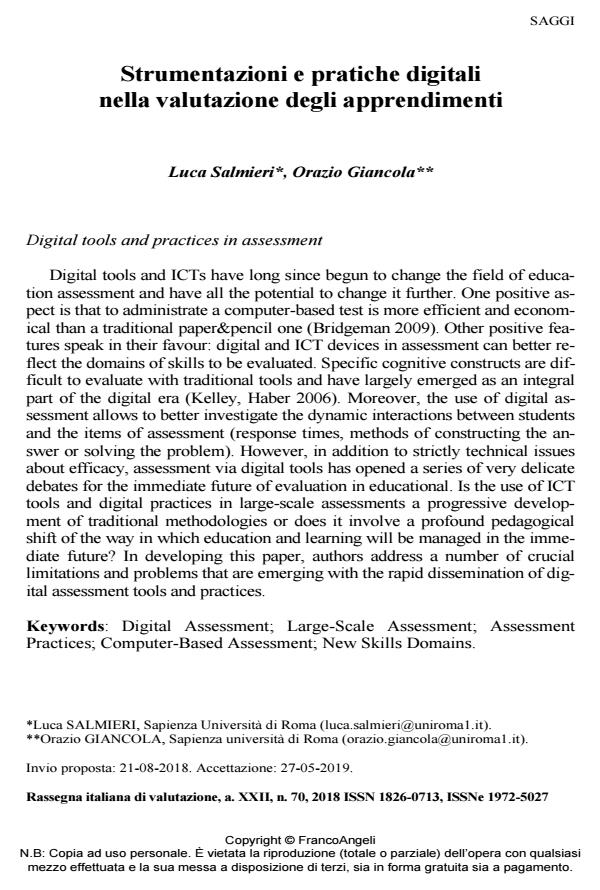Digital tools and practices in assessment
Journal title RIV Rassegna Italiana di Valutazione
Author/s Luca Salmieri, Orazio Giancola
Publishing Year 2019 Issue 2018/70
Language Italian Pages 23 P. 75-97 File size 543 KB
DOI 10.3280/RIV2018-070005
DOI is like a bar code for intellectual property: to have more infomation
click here
Below, you can see the article first page
If you want to buy this article in PDF format, you can do it, following the instructions to buy download credits

FrancoAngeli is member of Publishers International Linking Association, Inc (PILA), a not-for-profit association which run the CrossRef service enabling links to and from online scholarly content.
Digital tools and ICTs have long since begun to change the field of education assessment and have all the potential to change it further. One positive aspect is that to administrate a computer-based test is more efficient and economical than a traditional paper&pencil one (Bridgeman 2009). Other positive features speak in their favour: digital and ICT devices in assessment can better reflect the domains of skills to be evaluated. Specific cognitive constructs are difficult to evaluate with traditional tools and have largely emerged as an integral part of the digital era (Kelley, Haber 2006). Moreover, the use of digital assessment allows to better investigate the dynamic interactions between students and the items of assessment (response times, methods of constructing the answer or solving the problem). However, in addition to strictly technical issues about efficacy, assessment via digital tools has opened a series of very delicate debates for the immediate future of evaluation in educational. Is the use of ICT tools and digital practices in large-scale assessments a progressive development of traditional methodologies or does it involve a profound pedagogical shift of the way in which education and learning will be managed in the immediate future? In developing this paper, authors address a number of crucial limitations and problems that are emerging with the rapid dissemination of digital assessment tools and practices.
Keywords: Digital Assessment; Large-Scale Assessment; Assessment Practices; Computer-Based Assessment; New Skills Domains.
- La ricalibratura delle policy sull’ICT nella scuola italiana: “lezioni” dalla DaD Domenico Carbone, Cristina Calvi, Anna Rosa Favretto, in Cambio. Rivista sulle Trasformazioni Sociali /2024 pp.123
DOI: 10.36253/cambio-15541 - Valutare l’apprendimento precoce di una seconda lingua: rilevanza degli studi longitudinali Lucilla Lopriore, in EuroAmerican Journal of Applied Linguistics and Languages /2020 pp.11
DOI: 10.21283/2376905X.11.195
Luca Salmieri, Orazio Giancola, Strumentazioni e pratiche digitali nella valutazione degli apprendimenti in "RIV Rassegna Italiana di Valutazione" 70/2018, pp 75-97, DOI: 10.3280/RIV2018-070005